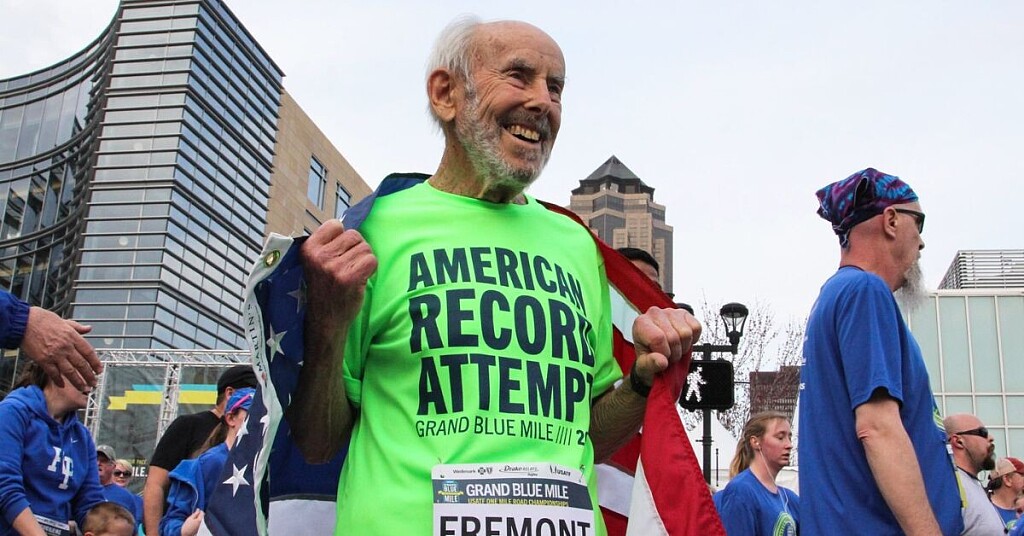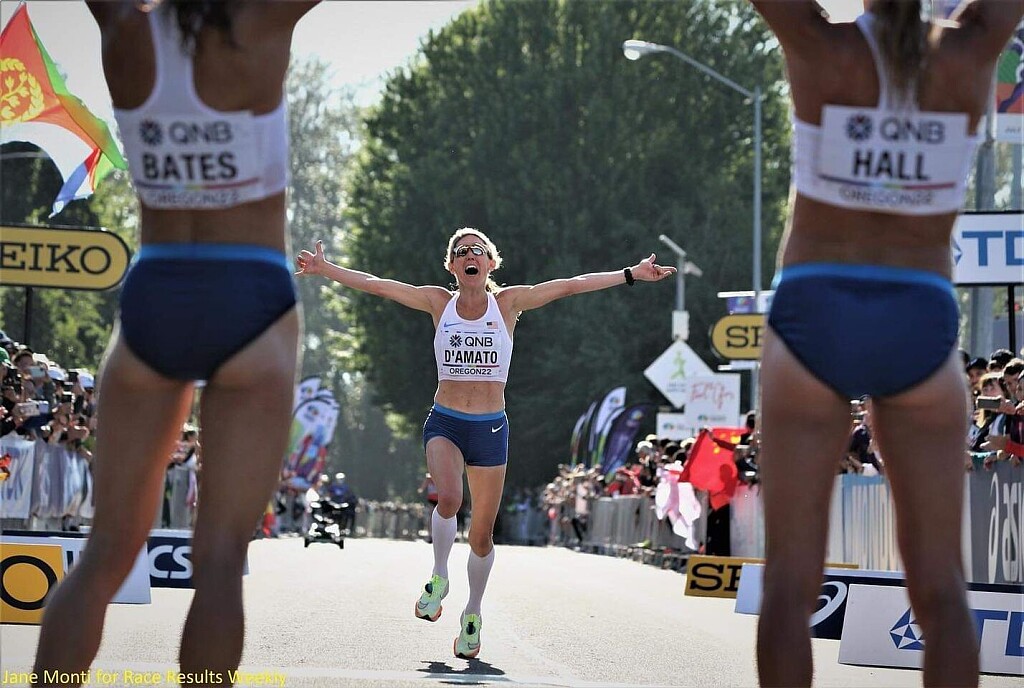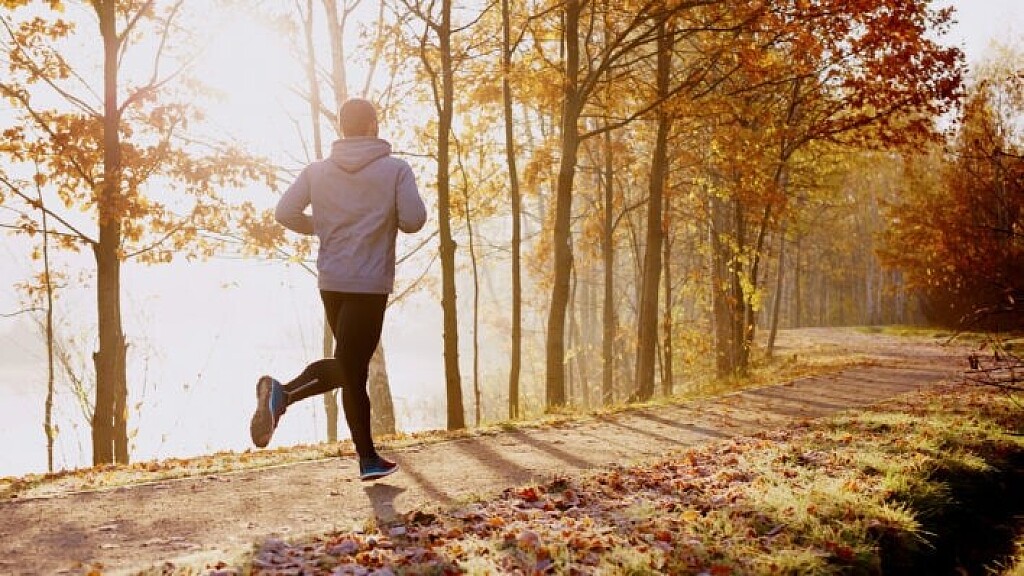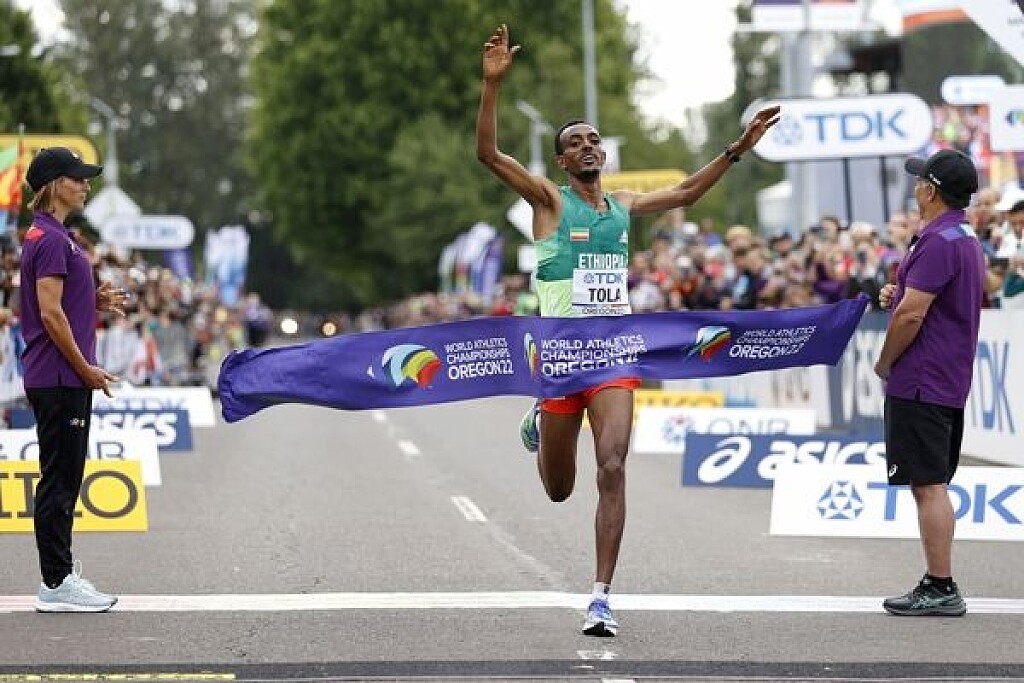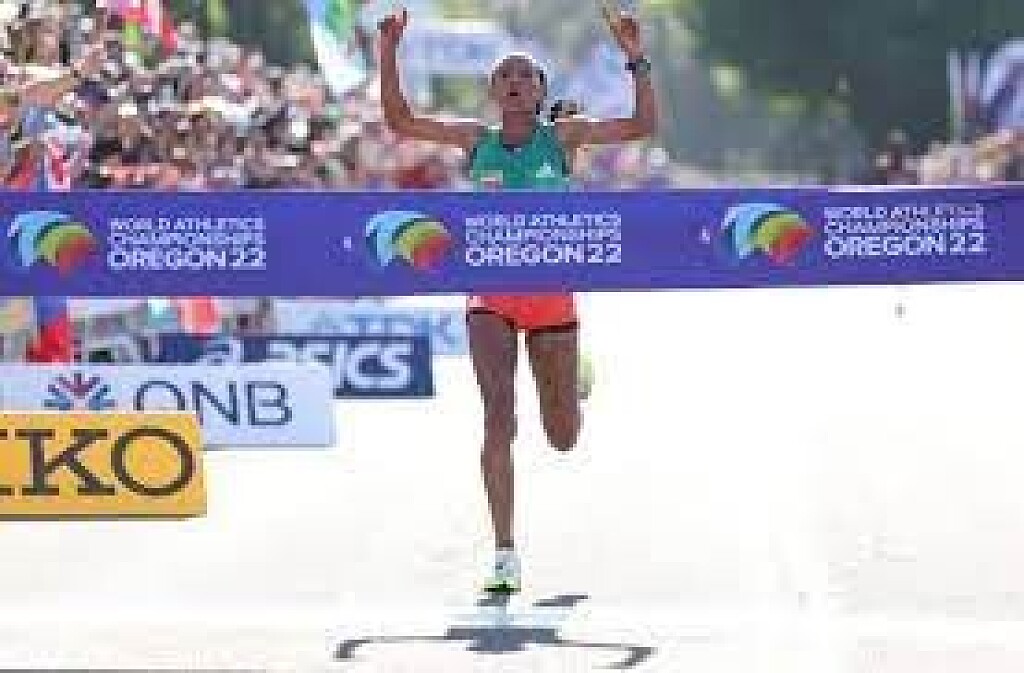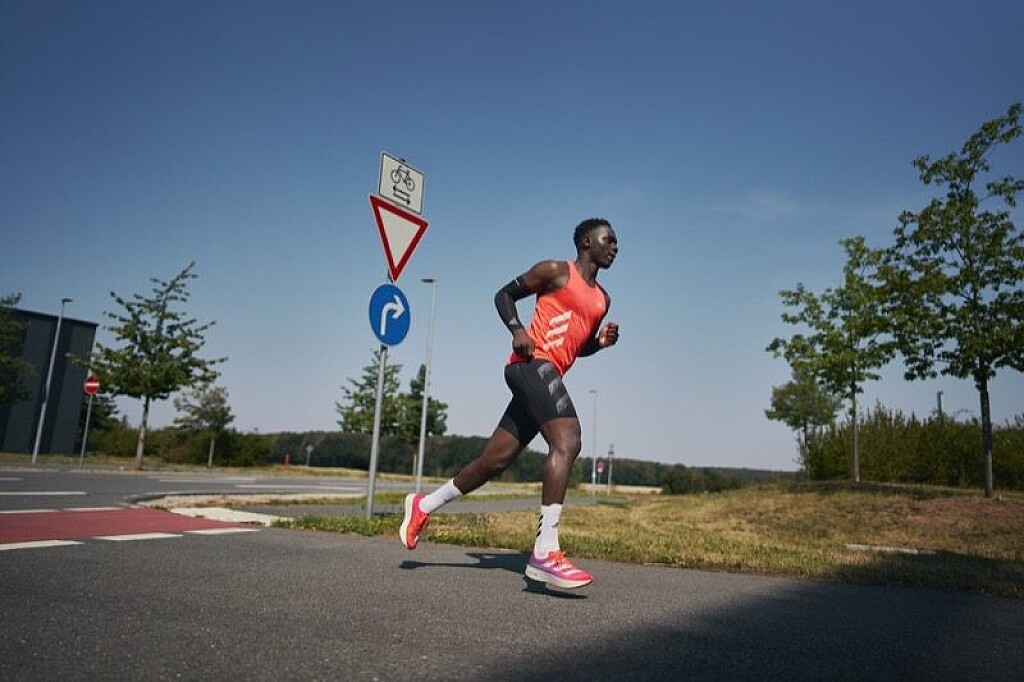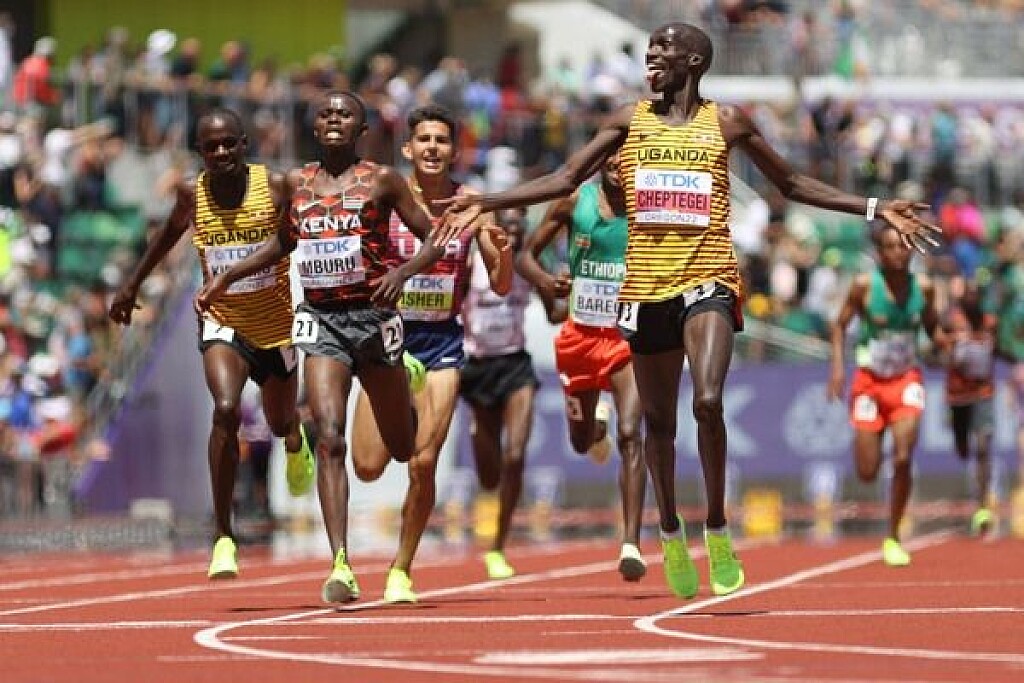Running News Daily
Top Ten Stories of the Week
7/23/2022
These are the top ten stories based on views over the last week.
100-Year-Old Marathon Runner Shares His Secret To Longevity
100-year-old marathon runner, Mike Fremont, set the fastest time for a marathon ever finished by a 91-year-old. He recently shared what he believes to be his secret to longevity in a podcast with Rich Roll.
“These, believe it or not, are the best years of my life.” You might not expect to hear that phrase out of the mouth of a centenarian, but that’s exactly what marathon runner Mike Fremont recently told author and podcaster Rich Roll.
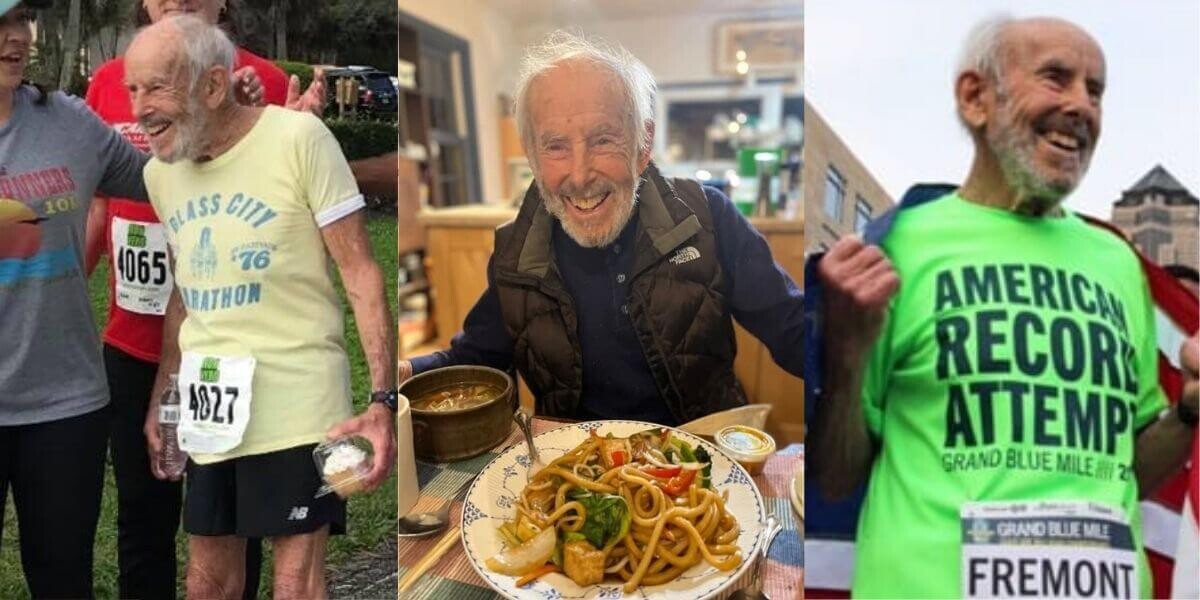
Fremont, who was diagnosed with colorectal cancer at the age of 69, and reportedly given three months to live, turned to a plant-based diet in an attempt to help shrink the cancer. According to Runner’s World, Fremont reckons he shrunk the tumour with his new diet, before having surgery in 1994 to remove what was left of it.
“The tumor shrank over the next two years and finally I killed it by diet alone,” Fremont said, according to Runner’s World.
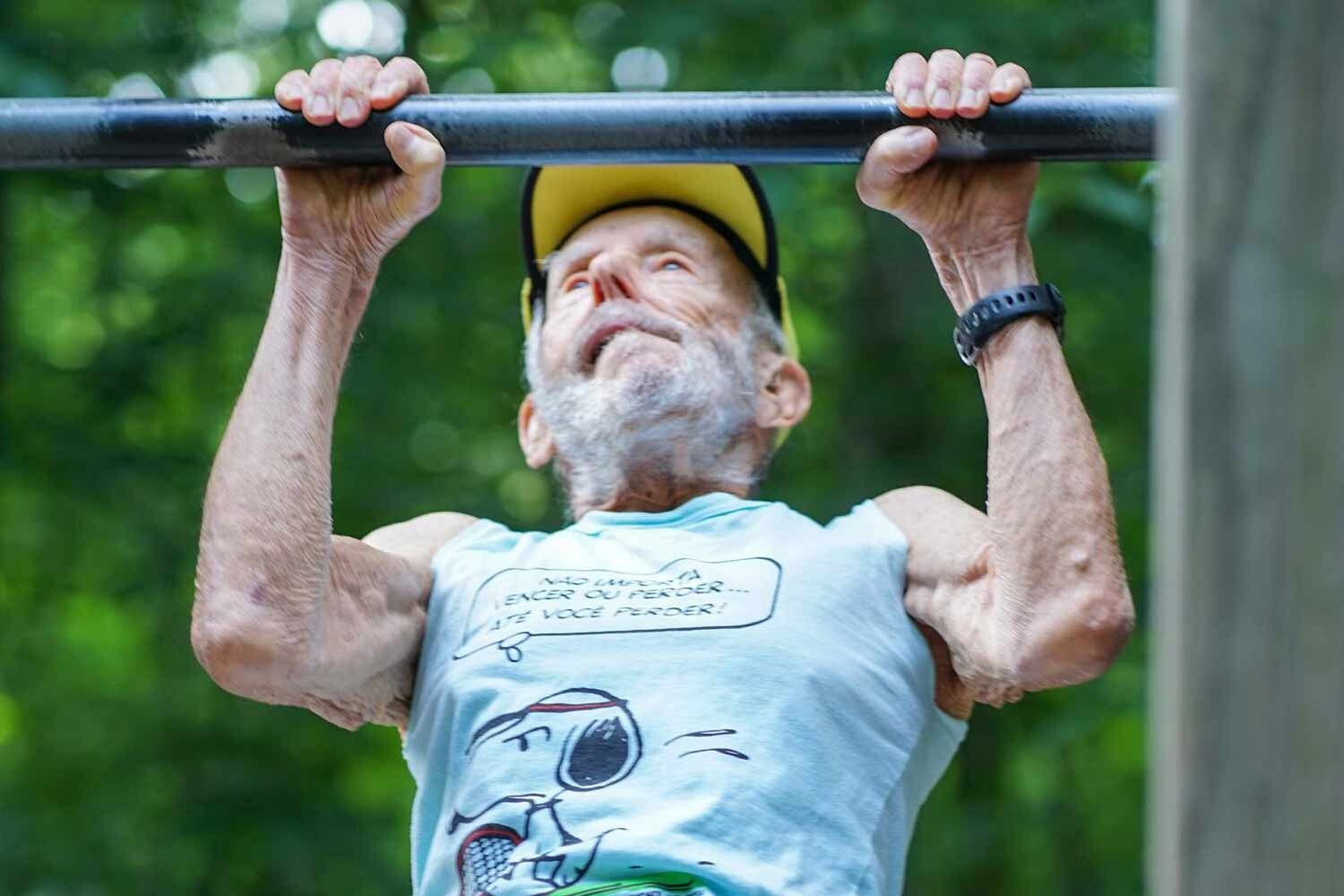
Speaking to Rich Roll in a video recently posted to Instagram, Fremont says: “No question in my mind – it is diet that has determined my existence, my continual existence and my beautiful health.”
He added: “I don’t think I ever became competitive until I was 88. For my age, I’m practically number 1.”
Fremont’s elite ultramarathoner buddy Harvey Lewis has also posted about the amazing 100-year-old recently, sharing some interesting insights. He posted a photo of Fremont doing pull ups with the caption: “5 miles with my 100 year young friend Mike Fremont. Mike also did 10 pull-ups at one go!”
“Mike’s mindset is strong. He fell this past spring in Florida and hurt his hip. He was reduced to a wheel chair for a month. That was really tough especially for Mike whose always on the go. When he restarted he could only do 1 pull up. Mike credited his Plant Based nutrition with his speedy recovery even as a centenarian in getting back his distance and reps of pull-ups.”
What does Fremont’s diet look like? As he once claimed, according to Runner’s World in 2013: “No meat, no dairy products, no toxins.” Fremont’s diet mainly comprises veggies, fruit, whole grains, nuts and soups, plus a bit of vitamin D in winter. In that same 2013 article, Fremont said since he started eating this way he hasn’t had a cold and maintains the same weight as his university wrestling years.
(07/21/22) Views: 109James Booth
Americans Hall, Bates, D’Amato Shine in World Championships Marathon A team effort pushed the Americans to three top-eight finishes
Ethiopia’s Gotytom Gebreslase ran the fastest, but Sara Hall, Emma Bates, and Keira D’Amato got the biggest cheers from the crowd at Monday morning’s world championship marathon in Eugene, Oregon.
Running in front of the home crowd, Hall, Bates, and D’Amato smartly hung back in the chase back for the first half of the race and then began to work their way up as some of the runners in the original lead pack began to blow up.
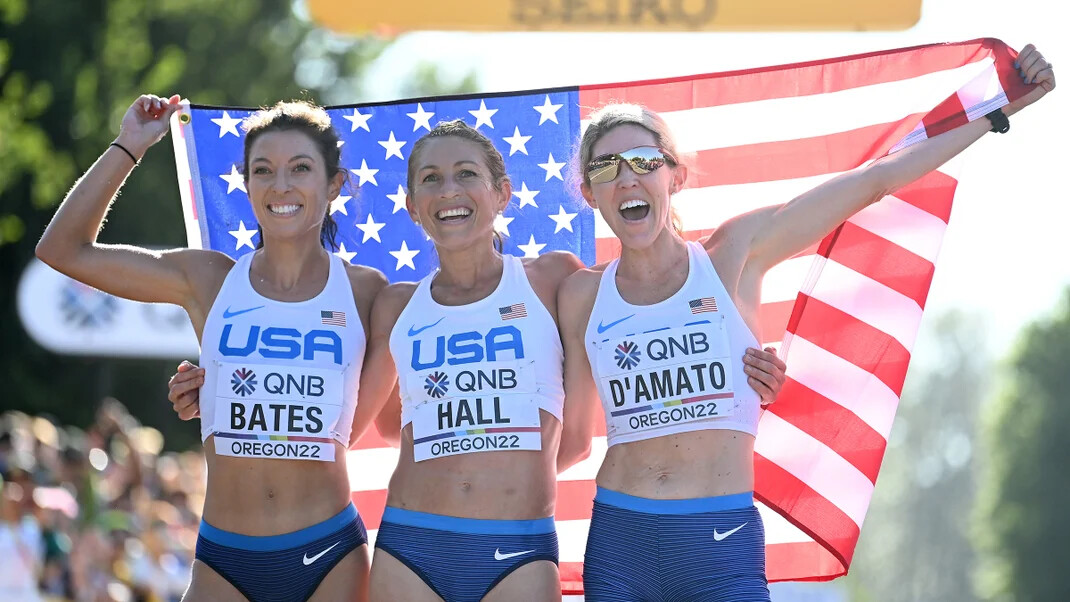
Hall (39, Crested Butte, Colorado) was the best of the bunch, surging throughout the final 8 miles of the race to place fifth in a season-best 2:22:10. She passed Kenya’s Angela Tanui (6th, 2:22:15) in the final mile but ran out of room in her pursuit of fourth-place finisher Nazaret Weldu of Eritrea (2:20:29). Hall’s finish was the best showing by an American woman in the world championships marathon since Amy Cragg earned the bronze in 2017 in London.
Bates (29, Boulder, Colorado) followed a similar strategy and wasn’t far behind in seventh in a new personal best of 2:23:18. D’Amato (37, Richmond, Virginia), who originally had gone out a bit harder only to get stuck in between the first two packs, eventually settled in with the chase pack alongside Hall, Bates, and British runner Jess Piasecki and Uganda’s Immaculate Chemutai.
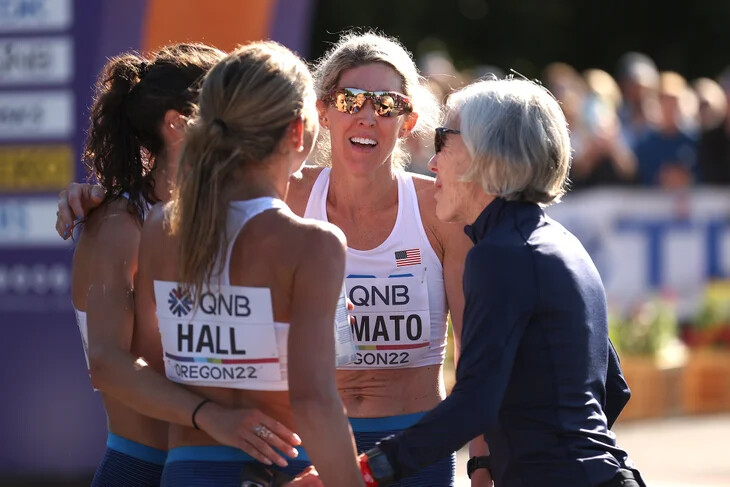
Hall, Bates, and D’Amato received roaring cheers from the crowd along the course that sent runners between Eugene and nearby Springfield, especially along the finish chute on Dr. Martin Luther King Drive. None had represented Team USA at a global outdoor championship before.
They were greeted at the finish line by American running legend Joan Benoit Samuelson, who won the 1984 Olympic marathon and served as the official starter of the women’s world championships race.
(07/18/22) Views: 103BRIAN METZLER (Women's Running)
Seven reasons why you should start your day with a run
As we enter a new season, the long-awaited arrival of summer. Here are seven reasons why you should begin your day with an early morning run this summer.
1. Start your day off right with a dose of endorphins:

In light of mental health awareness, self-care, and the stress of a g0, go, go society, a short 20-30 minute run stimulates the release of serotonin, a powerful endorphin. This endorphin is responsible for mood. Lower levels are linked to depression, while the running, a common form of exercise, is a strong stimulant of serotonin. Even being used in some cases as therapy to help treat depression.
2. Running fasted:
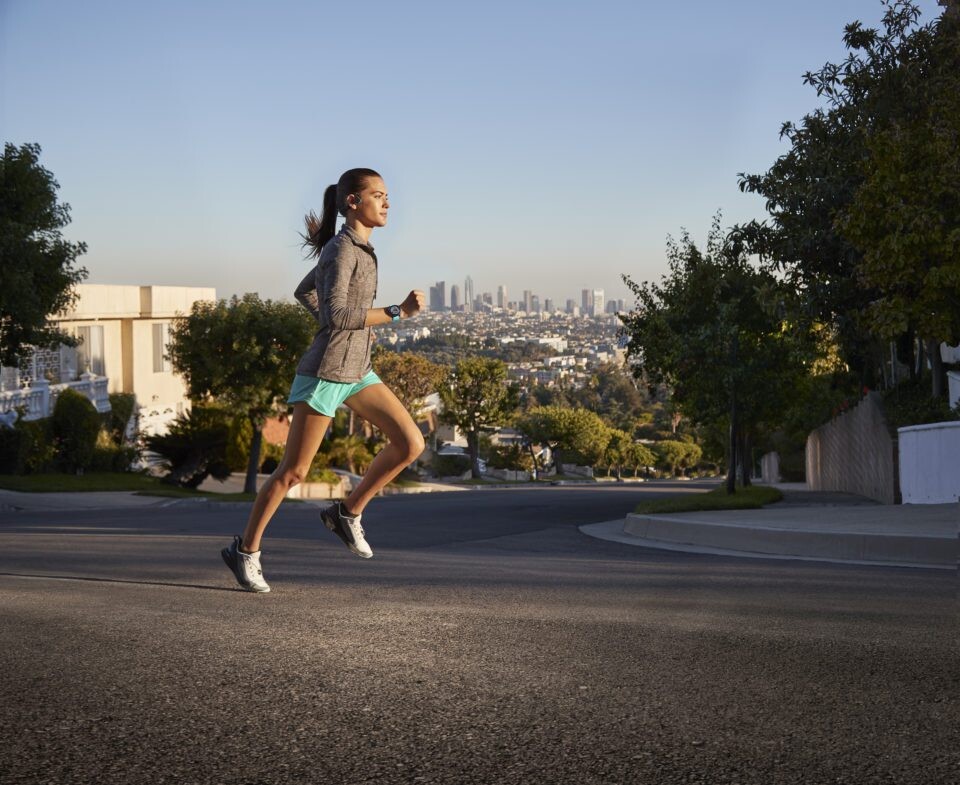
The idea of waking up and going for a run before breakfast may seem daunting, yet it can have real health benefits. With little to no available glucose to produce energy, the body has to turn to fat oxidation to produce energy for the muscles. All fat oxidation is, is a fancy way of saying the body is going to breakdown fat in order to get energy. So, by going for a run before breakfast you are helping control your body weight by kickstarting your metabolism.
3. Time effective:
Simply put, by waking up a bit earlier in the morning you are able to fit in that run session for the day. All without the stress of trying to fit in a run after work.
4. Quiet before the storm:
It’s quiet when you’re outside on the streets at 6 am. There is no pedestrian or vehicle traffic. You can hear yourself think. You have the time and space, just to be.
5. Nature and wildlife:
Without the hustle and bustle of traffic, and people going a million different directions you are able to enjoy nature. Whether it’s around your local pond or you are able to hit the trails. The morning is the perfect time to spend time in nature before going off to work.
6. Temperature:
It’s summer, and the days are now getting significantly hotter. Beat the heat by going out in the early morning! It’s a great way to fit in a hard workout without coming home absolutely drenched from a run in 25C plus heat.
7. A feeling of accomplishment:
You did it! No matter what the day throws at you, you accomplished something this morning that is good for your physically, mentally and psychologically.
Having said all that, getting up and going some form for physical activity is always good. What you do in the morning sets the tone for the rest of your day.
(07/20/22) Views: 100Cam Mitchell
Tips for older runners to minimize aches and pains, stay safe, and have fun
So you want to start exercising more after a lifetime of cubicle-dwelling, and have settled on the sport of millions: running. Congrats — it is great exercise, and it can be very rewarding.
But please — if you’re over 50-something, or even younger and truly out of shape — do not simply lace up an old pair of sneakers and charge out the front door.
First, run the idea past your primary-care doctor. A physical exam may identify cardiac issues or other limitations that warrant trying a different form of exercise, instead.

And even after you obtain a clean bill of health, there are practical considerations to keep in mind. We spoke with Joseph Daigneau, owner of Persevere Physical Therapy in Philadelphia, and Dave Welsh, owner of South Jersey Running Co., for tips on how to stay safe, avoid frustration, and above all, have fun.
1. Where to run
One of running’s appeals is that no special facilities are required. Still, it is wise to choose a location carefully, especially as you get on in years.

Among the pitfalls: Older folks may not pick up their feet as high as younger people, Daigneau says. If you run on the sidewalk, beware of cracks and uneven pavement that can send you sprawling.
The same goes for running on grass. The forgiving surface may be more appealing than concrete. But for those who are less able to react quickly, hidden dips and depressions can result in a fall or sprained ankle.
A better choice may be a good paved trail in a park. Welsh recommends a high-school track, changing directions periodically or staying in the outside lanes in case the tight turns cause muscle strain.
Yet another option is to run in the street — but in that case, be aware of point number 2:
2. Seeing and hearing
In many states, including Pennsylvania and New Jersey, traffic laws dictate that if sidewalks are available, runners and other pedestrians must stay out of the road. If you must run in the street, stay on the left-hand side, facing traffic. That way, you can see oncoming motorists and get out the way, if necessary.
Above all, don’t assume that drivers can see you. It’s no secret that some people glance at their phones while behind the wheel, or even send a text, despite laws that prohibit it.
If running after dark, wear reflective gear. Many running shoes have shiny logos that reflect vehicle headlights, but that isn’t enough. Consider wearing a vest or light jacket with reflective material.
And resist the urge to wear headphones, lest you fail to hear traffic. That goes double for older people, many of whom have a hearing loss. Consider running with a partner so you can look out for each other, or even a group affiliated with a running store. There is safety in numbers; plus, it’s more fun.
3. Start slow
If you have not exercised in a while, the joints are going to be a bit creaky. Start slow. If running seems daunting at first, feel free to walk, instead.
Daigneau tells novice runners to start by making sure they can walk for 30 minutes with no pain. Then they can graduate to a combination approach: repeated cycles of six minutes of walking followed by four minutes of running at a moderate pace. If you complete five of those repetitions (50 minutes’ worth), that amounts to 20 minutes of running — a respectable goal.
Even after you build up strength and endurance needed for sustained running, there always will be aches and pains. That is true at any age.
The key is to distinguish between regular soreness and the type of pain that suggests you are overdoing it. Daigneau says that if soreness persists beyond two or three days, it’s time to dial it back.
Sudden, sharp pain also is a red flag. When in doubt, stop. Don’t be reluctant to seek medical attention.
4. What to wear
At any age, a runner’s most important purchase is a good pair of shoes. The topic merits an entire article, but at a minimum, keep these tips in mind:
Running shoes generally should be at least a half-size larger than other footwear, Welsh says. That’s because a runner’s feet and toes swell during the course of a run, and they also spread out each time the shoe hits the ground. A bit of extra space is essential.
Older runners may like a shoe with more cushioning, but the most important attribute is a good fit. A trip to a store with trained salespeople is a smart idea.
The shoes can be pricey, sometimes running more than $100. If that’s too steep, ask whether the store has older models at clearance prices.
(07/15/22) Views: 94Tom Avril
Tamirat Tola from Ethiopia runs championship record to take world marathon title in Oregon
Ethiopia’s Tamirat Tola, world silver medallist in 2017, is the world marathon champion of 2022 after a masterful and ruthless run at the World Athletics Championships Oregon22 saw him come home more than a minute clear in a championship record of 2:05:36 on Sunday (17).
His teammate Mosinet Geremew won a protracted battle for silver, pulling clear of Tokyo Olympic bronze medallist Bashir Abdi over the final kilometre to finish in 2:06.44, with the Belgian taking another big bronze in 2:06.48.
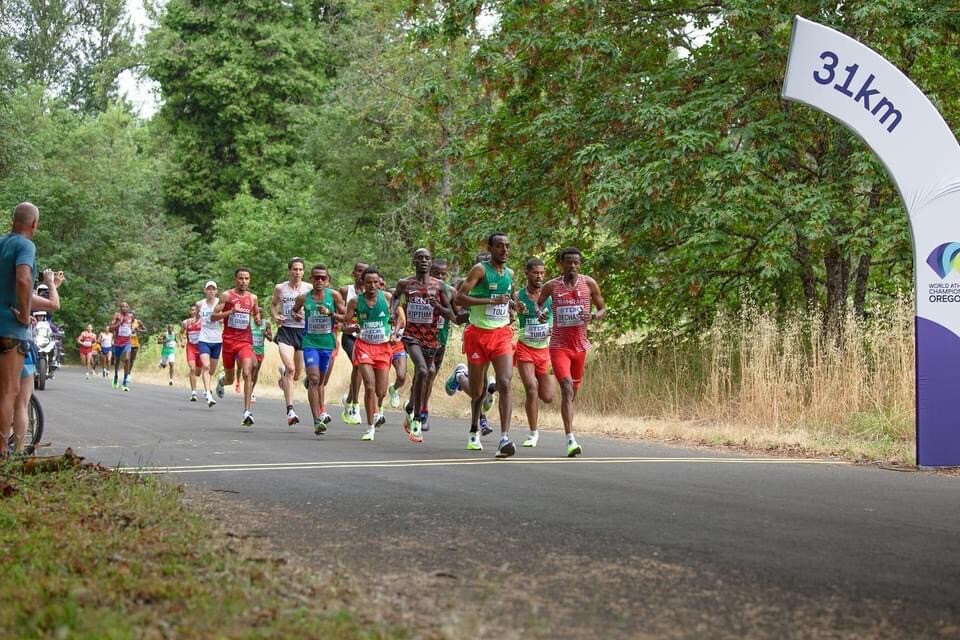
Missing the medal podium by one place was the unlikely figure of Canada’s Cameron Levins, who had the consolation of setting a national record of 2:07:09 ahead of Kenya’s three-time world half marathon champion Geoffrey Kamworor, who clocked 2:07:14.
"It was a dream come true," Tola said. "I learned from my mistake in 2017 (World Championships) and I made sure it did not happen again."
On that occasion, Tola’s attempted run for home 10km from the end was thwarted as Kenya’s Geoffrey Kirui overtook him to win gold. This time there was no faltering on the 30-year-old Ethiopian’s part.
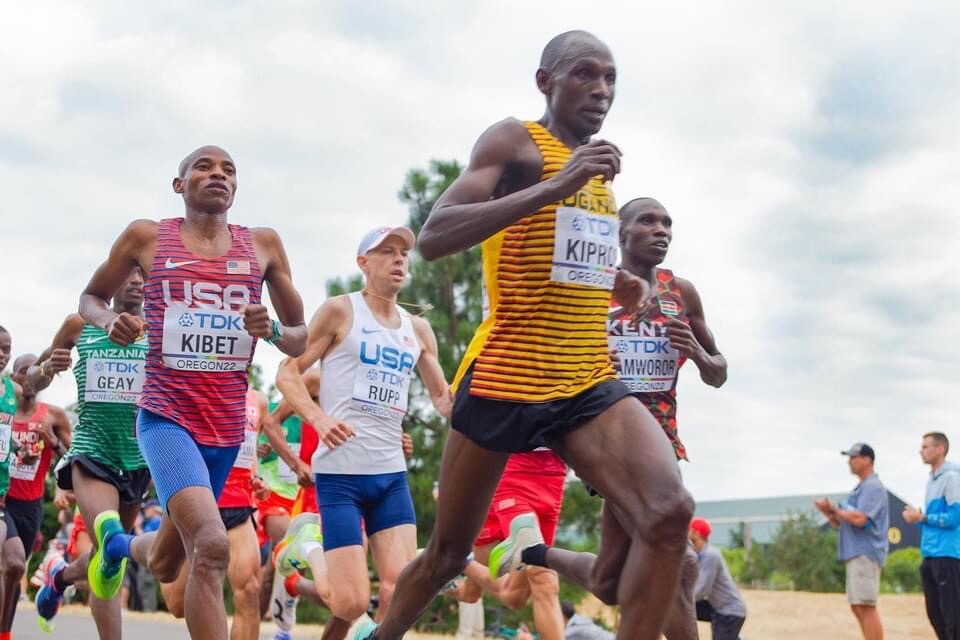
In what was the first event of day three at the championships in Oregon, Tola took more than a minute off the record of 2:06:54 set by Kenya’s Abel Kirui at the 2009 edition in Berlin.
But that was no more than an adornment for him on a day when he ran with apparent certainty from start to finish, never being far from the lead in a race that proceeded without undue vigour towards a halfway time of 64 minutes – comfortable territory for today’s elite marathon runner.
Conditions on a course consisting of three 14km loops running through Eugene and Springfield – home of The Simpsons – were an overcast sky and temperatures rising, not dramatically, from 13C at the starting time of 6:15am.
But there were no big city marathon pacers here. This was a championship race, with all the uncertainty that has traditionally involved. While the first half offered hope of success for many who were among the event's fastest, that hope was suddenly and ineradicably quashed by the eventual winner in the telling final quarter of the race.
Tola shaped what had been a largely inchoate procession of surging and slacking when he took off between the 33rd and 34th kilometres. It was not a drill.
By the 34km marker his lead was seven seconds. At 35km it was 12 seconds, at 36km it was 17 seconds and at 37km it was 26 seconds. With 5km to go, the gold was gone and the drama of the race resided in which of the chasing group of four – Abdi, Geremew, Levins and Kamworor – would share the podium.
Geremew’s big move, when it came with a kilometre remaining, was as decisive as that of his compatriot. Very suddenly he was a silver medallist in waiting and Abdi seemed to be looking back down the field a lot in the closing stages, perhaps seeking his training partner Abdi Nageeye, who had so vigorously encouraged him to keep going in pursuit of a medal in Tokyo last summer.
As it happened, Nageeye was one of eight runners who failed to finish, in company with Ethiopia’s defending champion Lelisa Desisa, who was not thought to be in good form and who confirmed that speculation as he struggled out of contention by the halfway point.
The race had begun with bad news for Japan, whose charismatic national record-holder Kengo Suzuki did not start.
America's Galen Rupp, who had run this course innumerable times as a former alumnus of the University of Oregon, was seeking to add another global marathon medal to the bronze he won at the Rio 2016 Games. But after hitting the front briefly at the halfway point, taking the field through 22km in 66:58, he dropped away to finish 19th in 2:09:36.
(07/17/22) Views: 89World Athletics
Gotytom Gebreslase Wins World Marathon Gold in Championship Record
With a strong downhill surge in the 41st kilometer, Gotytom Gebreslase of Ethiopia won the 2022 world marathon title in 2:18:11. The time set a new championship record; the previous mark of 2:20:57 was held by Paula Radcliffe.
Judith Korir of Kenya, who led Gebreslase by half a step for most of the closing miles, finished second in 2:18:18, and Lonah Salpeter of Israel took the bronze medal in 2:20:18.
Sara Hall was the top American finisher, placing fifth in 2:22:10. Emma Bates placed seventh in a personal best of 2:23:18, and U.S. record-holder Keira D’Amato finished eighth in 2:23:34. D’Amato was added to the team at the beginning of the month after Molly Seidel withdrew because of injury. The three ran together through the middle miles until Hall, ninth at halfway, pulled away and started picking off former members of the lead pack.
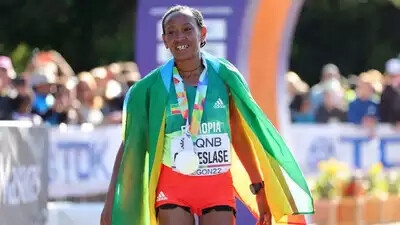
Today’s 5-7-8 is the best team performance by a U.S. squad, male or female, since the marathon world championship was first run in 1983. They succeeded thanks to just the right mixture of aggressiveness and patience.
“I went out with the leaders, but then I could tell it was a little too fast,” Hall said. “So fortunately I had talked to Emma and Keira and been like,‘Hey, I’d love to work with you guys. I don’t want to mess up your mojo, but if we’re together somewhere I’d love to work together.’ So thankfully Emma and I found each other.
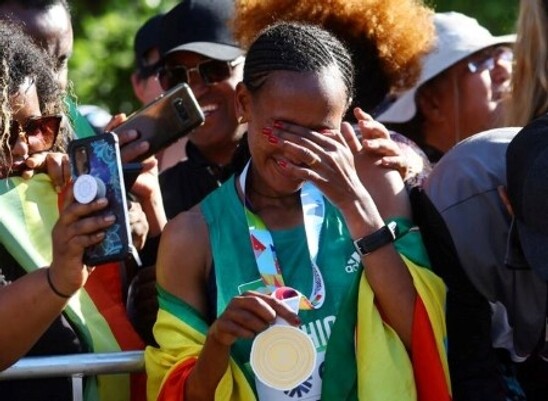
"I was checking our splits and we were running plenty fast out there, so I didn’t really want to run faster than that,” Hall continued. “It was awesome to get to work with [Emma] for so much of the race.”
Bates, who was the top American at Chicago last October, said, “My coach and I had decided that I go out in 70-minute pace for the first half. Which I had never done before, that’s close to my PR for the half marathon. We knew I could be in 2:20 range, fitness-wise.
“I went out with Sara. We were planning on working together before the race, so it was great the first lap to be with each other and then the second lap. Sara took off the later portion of the second lap. So proud of her today for going after it. She really pulled me along that first bit.
“I’m very happy,” Bates continued. “I always want more, we always want more. But to be top 10 in the world is something really really cool, especially on U.S. soil. And to run a PR doing it, it’s something that I won’t forget.”
Well past 30K, Hall was still acknowledging cheering spectators (including Olympian and fellow Flagstaff resident Rachel Schneider).
“I think this is the most fun I’ve ever had in a marathon,” Hall said. “I wanted to smile as much as I could early on, ’cause you know its gonna turn to a grimace eventually. But I was even smiling that last lap. I’m really thankful for everyone that turned out, ’cause I knew that this would be so special. I don’t know if I’ll ever get the opportunity to run a championship like this in the U.S. again.”
How the Race Was Won
Within the opening kilometer, it was obvious that the script for yesterday’s men’s marathon—a huge lead pack running cautiously for the first half—would be ignored. Headed by three Kenyans and three Ethiopians, the leaders took off at 2:17 marathon pace. D’Amato started with the pack but dropped back in the fifth kilometer; in the 12th kilometer, a chase pack led by Bates and Hall caught D’Amato, who then tucked in.
Toward the end of the first of three 14-kilometer loops, the chase pack got within 11 seconds of the leaders. Korir then spurted ahead just before an aid station. That reestablished a quicker tempo for the leaders, and the chase pack’s hope of joining the leaders was permanently ended.
The first significant event occurred in the 19th kilometer, when defending champion Ruth Chepngetich of Kenya stepped off the course, apparently looking for tall grass in which to make a pit stop. Sensing an opportunity, Gebreslase and fellow Ethiopian Ababel Yeshaneh surged on a downhill stretch. Subsequent kilometers of 3:05 and 3:09 (an average of roughly 5:00 mile pace) pared the group to four. They passed halfway in 69:01; the chase pack, including the three Americans, hit halfway in 70:17.
Toward the end of the second lap, Korir again surged approaching an aid station. Her teammate Angela Tanui briefly lost contact for the second time, clawed her way back, but was then dropped for good. In the 27th kilometer Yeshaneh started grabbing at her side and was left by the eventual gold and silver medalists.
Korir and Gebreslase ran within inches of each other for most of the third lap; the Ethiopian was usually just off of Korir’s right shoulder. Korir occasionally motioned to her rival to either help with the pace or back off a bit. It was hard to tell who was feeling more feisty or fatigued.
Or at least it was until the overpass over Route I-5. After cresting the summit, Gebreslase leaned into the long, gradual descent toward the finish. She almost immediately had two, then three, then five seconds on Korir. Gebreslase, who won Berlin last fall, had judged her effort perfectly. For the second day in a row, an Ethiopian won the world title in a championship record.
(07/18/22) Views: 89Scott Douglas
Why run tall is bad advice, the connection between correct running posture, glute activation and quad dominance, explained
You may have heard a lot of advice to keep your shoulders back when you run, or to be mindful of having good posture, or to “run tall.” This advice sometimes even comes from seemingly well qualified people, but it’s based on a fundamental misunderstanding. The best posture for running is with a slight forward lean, which engages your glutes–the body’s largest and strongest muscles and the source of running power.
You may also have heard a lot of advice about “activating your glutes” when you run. This is good advice–but it’s not something you need to do consciously, as long as you’re running with a slight forward lean, as movement expert Jae Gruenke explains in the video.
Moreover, the advice to strengthen your glutes is of little value if you are not running in such a way that your glutes are engaged.
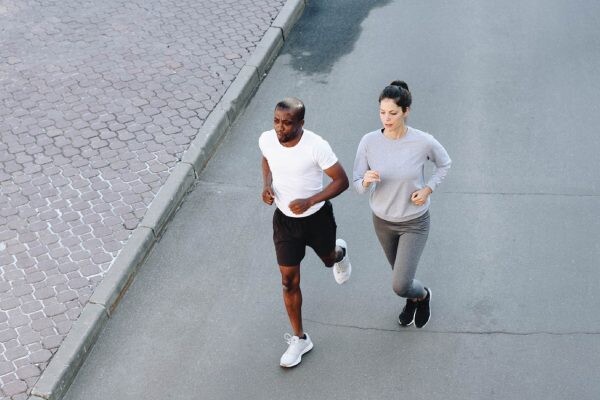
Running with a very upright posture means your weight is too far back for powerful running, and is likely to result in your becoming a “quad-dominant” runner, i.e. a runner who is mostly using their quads, at the expense of their glutes and hamstrings, when they run. (This may also be associated with knee pain, lower back pain and plantar fascia issues, according to Gruenke, who frequently sees this in her practice.)
You may feel like your running is fine, but your quads are likely often sore after a long or hard run, and you are probably not running as powerfully (or as fast) as you could be, even at lower efforts. Moreover, the advice to activate your glutes will seem mysterious, since it’s impossible to do if you’re not leading with your head and chest. (And you do not need to consciously contract your glutes in order to activate them.) Running with a slight forward lean will also greatly improve your ability to run uphill.
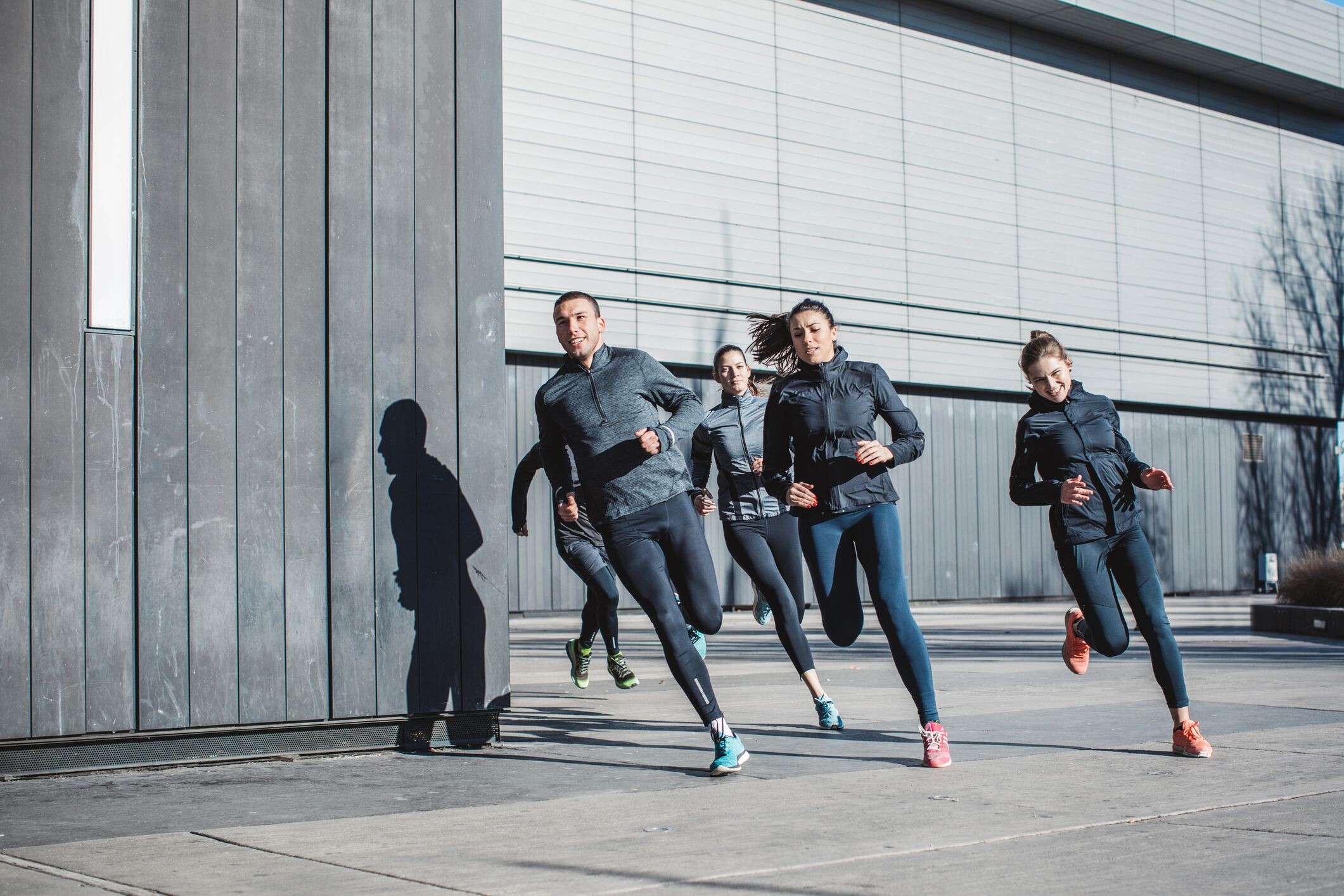
The problem, Gruenke explains, is the assumption that leaning forward when running tilts your pelvis in a way that makes it difficult to engage your glutes; but that assumes that your muscles function the same way when you’re standing, sitting or performing a deadlift as when you’re running, which is not the case. In fact, you must tilt your pelvis forward in order to engage your glutes when running, and take the full load off your quads.
One way to test this is to stand with your knees slightly bent, feet slightly apart, in a forward-leaning position, and hold it for a couple of minutes; you will soon feel your glutes working.
If you’ve ever watched champions like Jakob Ingebrigtsen or Timothy Cheruiyot run, you’ll see the forward lean in action. (It’s not a coincidence that they usually dominate in races!) Granted, they’re running much faster paces than the average runner, but the principles are no different.
(07/15/22) Views: 83Anne Francis
Kenyan-born Jeruto wins steeplechase gold, Chespol struggles
Kenyan-born Kazakhstan Norah Jeruto staged a brilliant performance to win the women's 3,000 meters steeplechase final in the World Championships in Oregon, United States early Thursday morning.
Kenyan-born Bahrain star Wilfred Mutile Yavi appeared set to challenge Jeruto for the gold, but stumbled on the last water jump, allowing the Ethiopians to pass her.
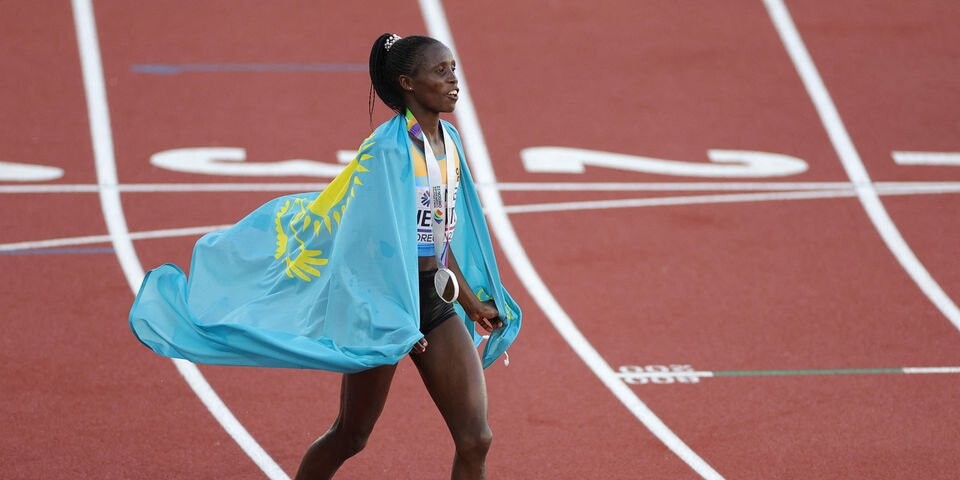
Jeruto's victory means Kenya has lost another world title from 2019 Doha.
After leading for most part of the race, Yavi stormed to the lead after the bell but Jeruto would reclaim the lead immediately, tackling the last water barrier majestically to win in eight minutes and 53.02 seconds.
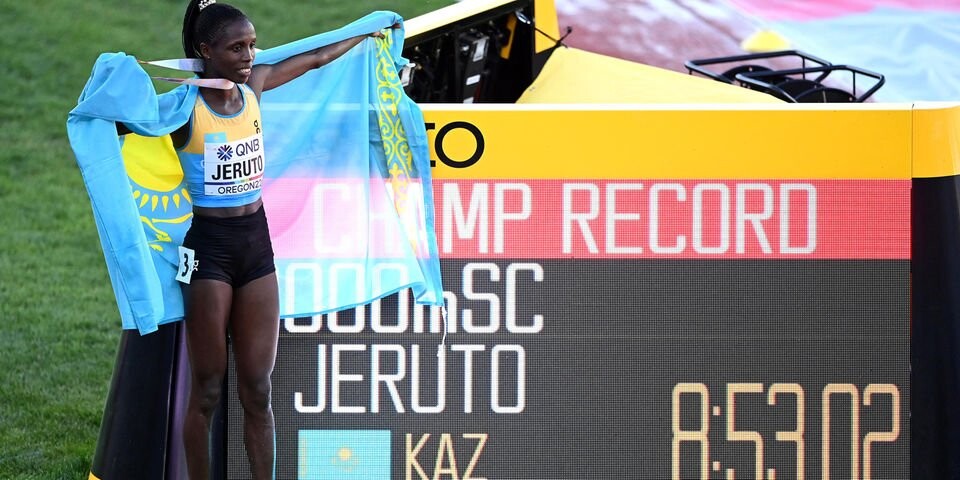
Jeruto, who failed to compete at the Tokyo Olympic Games last year as she was still chasing transfer of her allegiance, obliterated Kenya’s Beatrice Chepkoech’s CR from the previous 2019 Doha event by five seconds.
Yavi’s last water jump proved awful to cost her a medal as Ethiopians Getachew and Abebe zoomed past her to settle for silver and bronze.
Getachew came second in a National Record of 8:54.61 as Abebe cracked a personal best of 8:56.08.
Yavi, who was the fastest in the field, came fourth in 9:01.31 as Kenya’s Celliphine Chespol settled a distant 13th in 9:27.34.
It was the fourth title Kenya was losing from its tally in 2019 Doha after the women's marathon, men's 1,500m and men's 3,000m steeplechase.
The only title Kenya managed to defend her title is women's 1,500m by Faith Chepng'etich.
(07/21/22) Views: 83
Ayumba Ayodi
Cheptegei leaves rivals with no response to retain world 10,000m title in Oregon
Just like the Olympic final in Tokyo, there was a mass queue of runners still in contention as the bell sounded in the men’s 10,000m final at the World Athletics Championships Oregon22.
On that occasion there were seven men remaining in the hunt for gold. This time there were eight.
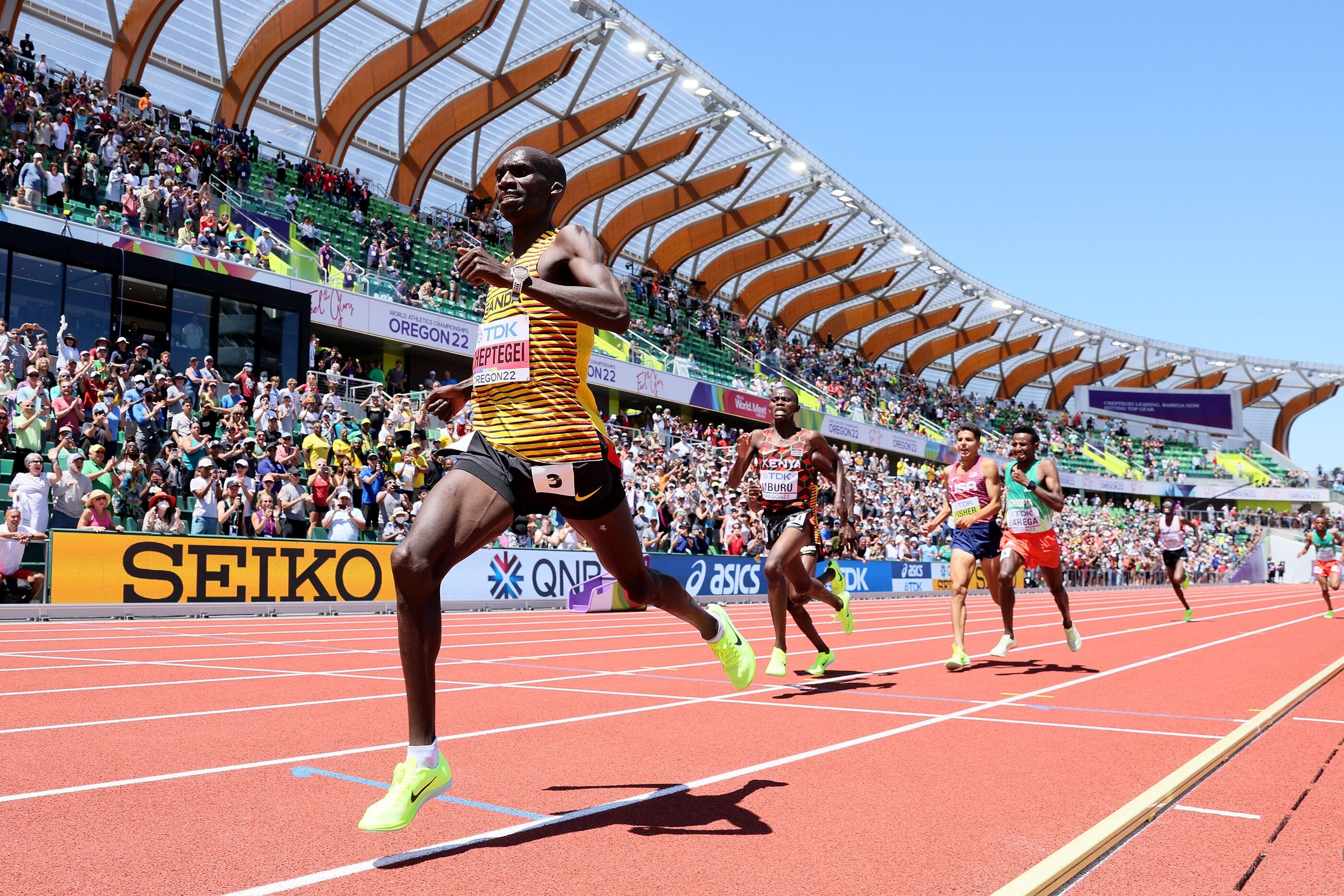
There was another subtle difference as the 25-lap event built up to just as thrilling a crescendo as the women’s final the previous day.
In Tokyo the slender Ethiopian Selemon Barega refused to budge from the front, keeping ahead of Uganda’s Joshua Cheptegei with a 53.9 final lap.
In Eugene, having controlled most of the race from halfway, Cheptegei hit the front again at the sound of the bell and stayed there. The fastest man in history at 5000m and 10,000m was not going to relinquish the title he toiled to gain in Doha three years ago.
Barega moved on to his shoulder down the back straight and looked set to pounce with 200m to go, but as Cheptegei led round the final bend and into the finishing stretch the world indoor 3000m champion had nothing in the tank.
Like Sifan Hassan in the women’s final, Barega faded out of the medals. Like Barega’s compatriot Letesenbet Gidey, Cheptegei gritted his teeth and kept his feet on the gas. The 25-year-old could afford to open his arms in celebration as he crossed the line 0.47 clear of his closest pursuer in 27:27.43.
In doing so, Cheptegei became only the fourth man to win back to back 10,000m world titles, following in the footsteps of Ethiopians Haile Gebrselassie and Kenenisa Bekele and Britain’s Mo Farah. His final lap was faster than Barega’s in Tokyo: 53.42.
"I knew that if I could get into the last fight, I could control it and I could speed it up," said Cheptegei, who won the world U20 title back at Hayward Field eight years ago. "It was very emotional for me to come back to the USA where I started my international career in 2014. Now, I want to continue my dominance in long distance running and I hope I will manage it."
The surprise silver medal winner, in 27:27.90, was Stanley Mburu. The world U20 silver medallist at 5000m in 2018, the 22-year-old Kenyan had quickly regained his composure after falling on the opening lap.
As in the Olympic final, Jacob Kiplimo took the bronze medal, Cheptegei’s compatriot clocking 27:27.97 to resist the challenge of home favourite Grant Fisher. The spirited US challenger had to settle for fourth in 27: 28.14, with Barega fifth in 27:28.39.
There were Ugandan flags fluttering in the stands as the 24 runners took their place on the start line, the loudest cheer coming for Fisher, who settled into second as Spain’s Carlos Mayo led through 400m in 66.70.
Mayo remained in front through 800m in 2:12.72, 1km in 2:46 and 2km in 5:51, with Fisher maintaining in second spot and Cheptegei keeping a watching brief on proceedings in third.
After Mayo passed 3km in 8:20.08, Cheptegei’s teammate Stephen Kissa took over at the front but without upping the pace.
Indeed, the speed slowed to 2:51 for the fourth kilometre, prompting Barega to show his face at the front for the first time with 13 laps to go, reaching halfway in 14.01.32.
Kiplimo was first to make a notable injection of pace, stretching out the field with a 64.46 lap. When Cheptegei moved through on to his compatriot’s heels, Barega was alert to the potential threat, surging back up into third.
Cheptegei then took over at the front but slowed the pace to steady laps of 67 seconds. All the while, Barega breezed along, eyes fixed on the target on Cheptegei’s back as 15 men remained in contention.
With two laps to go, Mburu made the long run for home but at the bell there were still eight contenders. It was then, after a fleeing appearance at the front by Barega’s teammate Berihu Aregawi, that Cheptegei regained control – this time for good.
(07/17/22) Views: 80World Athletics
Seven Ways to Celebrate Your Running Progress
Experienced runners know that it’s important to celebrate milestones. If you haven’t recently taken a step back and thought about how far you’ve come, now’s a great time to think about your running progress.
Celebrating your running progress will not only help you appreciate how far you’ve come, but it will also keep you motivated to maintain your running habit. Whether you just finished a big race, ran double digits for the first time ever, or have been running on a consistent schedule for a few months, there’s always something to celebrate. Here are some ways you can pat yourself on the back about your running progress:

1. Buy yourself some new running gear.
Treat yourself to some new running gear, such as a new shirt or running socks, as a reward for your hard work. Or maybe you need a post-run pampering item, such as a foam roller. The treat will make you feel energized, and reinforce your commitment to your training.
After all, who doesn’t look forward to wearing that new, cool-looking running gear on a long run? If you don’t need any new gear, a massage or pedicure is always a nice reward. Plan a running treat for yourself.
2. Run in a completely new location.
I coach runners in New York City and we run over a lot of bridges during our long runs. Not only are the views spectacular when you’re running across the Brooklyn Bridge, but the runners feel an incredible sense of accomplishment by running from one borough to another.

Running in a new location will be a reminder of how much you can experience through running. Treat yourself to some new views, even if it means having to drive someplace to get to your run destination.
3. Tell someone you know will be proud of you.
Sharing your achievement with someone will make it more real. Whether it’s your running buddy, your significant other, or your mom, tell someone you can safely brag to about your most recent running accomplishments.
4. Start calling yourself a runner.
I frequently hear people say they’re not “real” runners, even though they been running regularly for a while. You don’t need to sub-7:00 miles or run marathons to be a real runner. If you run regularly — no matter what pace or distance — you can proudly call yourself a runner. Start embracing the title!
5. Give yourself a running memento.
Treating yourself to a special keepsake just for runners such as a running medal holder, necklace, or race bib album is a great way to acknowledge your achievements. Every time you look at it, you’ll be reminded about how far you’ve come and how you can keep going with your running habit.
6. Mentor a new runner.
One way to show yourself how far you’ve come is to share your running knowledge and experience with others. If you have a family member or friend who’s expressed an interest in running, ask her if she’d like to join you for a run (at her pace), needs help shopping for running shoes and gear, or maybe even wants to train for a race together.
Not only will helping a new runner allow you to see and celebrate your progress, but you’ll also get a motivation boost and you may gain a new running buddy.
7. Plan your next race.
Committing to a race is a perfect way to pat yourself and give yourself a confidence boost about your running. It also helps get over any post-race blues you may be feeling after completing a big race, like a marathon. Pick a fun race that you’ve done before or perhaps always wanted to do and see if you can get some running friends to do it with you.
(07/18/22) Views: 80Christine Luff


